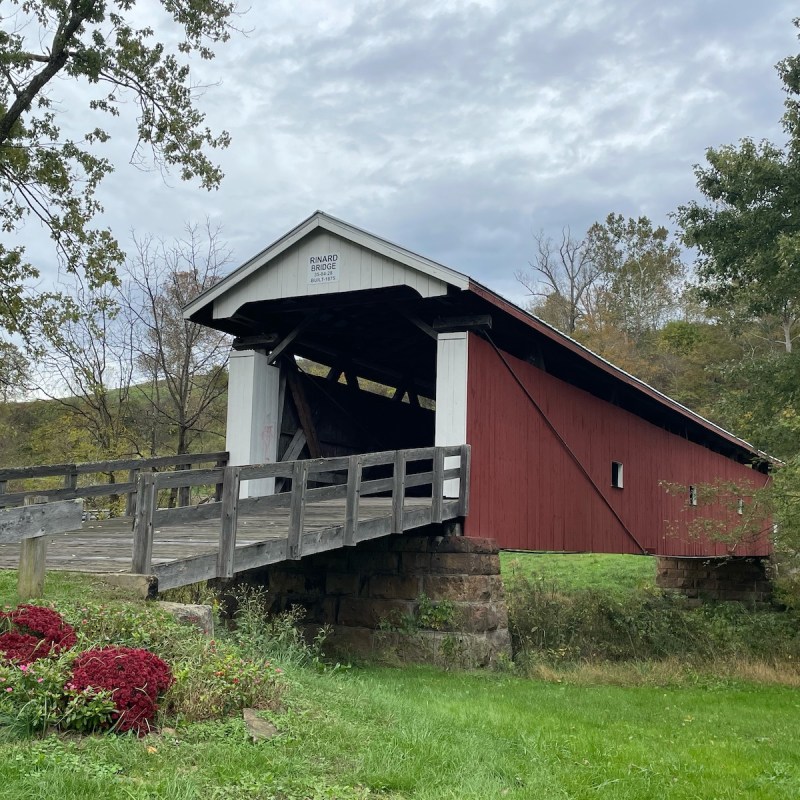
There are days on a vacation when you want to go everywhere, see everything, do everything. And there are other days when it’s time to slow the pace, savor the sights, and breathe deeply. The Wayne National Forest Covered Bridge Scenic Byway (is that the longest name ever?) in Ohio is perfect when you want a slower, relaxed pace.
Videos by TravelAwaits
This scenic byway follows a route along the Little Muskingum River, a meandering tributary of the Ohio River. If you’re a covered bridge fan like I am, you’ll be excited to hear that it features four of them, plus six other unique and historic stops. From the U.S. Forest Service: “The Covered Bridge Scenic Byway follows State Route 26 from Marietta to Woodsfield, Ohio. For most of its length, it parallels the Little Muskingum River. The scenic byway traverses some of Ohio’s most beautiful countryside.”
My husband Dean and I started our drive in Marietta and followed State Route 26 north. People who want to get from A to B quickly don’t take this road, so we saw very little traffic on a Tuesday morning. The byway is 44 miles but takes about 4 hours to drive and explore. You can go at your own pace and timing, thanks to a numbered online map and signage at each of the 10 stops along the way.
Pro Tip: We went in late October, and although the drive is still lovely, the fall colors were past their peak. I’d recommend early to mid-October for the best leaf colors. Check weather and leaf forecasts to be sure you’ve got the right timing.
Pro Tip: We weren’t sure what we’d find for restaurants along the way, so we stopped at a deli in Marietta to grab some sandwiches for lunch. That turned out to be a good call.
Here are the 10 unique stops that make it perfect for a relaxing fall drive.

1. Hills Covered Bridge
Covered bridges are a part of Americana, and Ohio once laid claim to having over 2,000 of them — more than any other state at the time. Today, Pennsylvania holds the coveted covered bridge crown.
The first stop is Hills Covered Bridge, built in 1878 by Hocking Valley Bridge Works. A sign told us it features a Howe truss. A bridge truss is an arrangement of rigid rods, posts, and timbers assembled to support each other, the bridge, and the accompanying weight the bridge would bear. (The sign provides an education in various truss types, if you’re interested.) We couldn’t walk on this bridge because it was barricaded, but we could see that local graffiti artists had been at work.

2. Mail Pouch Painted Barn
Advertising on barns is a thing of the past, but in the late 1800s, you can imagine how this form of advertising would be in high demand. A functional billboard of sorts!
Soldier Harley Warrick is legendary in the era of barn painting. Discharged from the Army at the end of World War II, he needed work. Mail Pouch Tobacco barn painters were hired to paint the barn on his family farm and gave Warrick a job. He became part of a two-man team that painted ads on two to three barns per day, 6 days a week. He chalked up some 20,000 barns throughout his barn painting career. A freeform artist, Warrick didn’t use guides or stencils. When asked how he did it, he reportedly said, “The first 1,000 were a little rough, after that you get the hang of it.”

3. Hune Covered Bridge
The third stop is the Hune Covered Bridge, built in 1879 and renovated in 1998. I loved this bridge because we could walk all the way through to the other side, as well as around it on another side thanks to the Duff Road bridge right next to it.
Oddly enough, bridges weren’t covered to protect weary travelers from snow or rain or to protect roads. The roofs were there to keep the bridge itself — the structural timbers — dry. Made of wood, these bridges would easily rot if left to fend for themselves against the elements.

4. Oil Well
This is oil country, and along the way, we saw oil wells in fields and meadows. In 1814, workmen struck black gold when they were looking for brine. At first, there wasn’t a big market for oil and some called it “devil’s grease.” Over time, demand increased, value rose, and the nickname all but disappeared. The brochure told us that some of these wells have a depth of 1 to 2 miles into the earth!

5. Hune House
In the late 1800s, small log houses or frame buildings were the typical lodging, but William Hune had other ideas. An early settler, Hune built the original house in 1885 and added on in 1889. Hune made his money in tobacco until oil was found on his property in 1900. The house was so sizeable that they likely had boarders, and the house was known as “Hune Inn.”
Pro Tip: This home is now a private residence; signs tell you to be respectful of the current occupants. Aside from stopping to take a quick photo and read the sign, we didn’t linger here.
6. Myers General Store
Today, we think nothing of video calling loved ones around the world in real-time, but think back to a time before the internet and cell phones. What did rural communities do to stay connected? The old country store, like Myers General Store, served as the communication hub for area residents. Serving the community since 1865, residents could send and pick up mail, use the only telephone in the area, or swing by on Sunday for a game or two of checkers. This building was showing its age, but I guess it’s got 150-plus years to show for it.

7. Rinard Covered Bridge
Built in 1875, stop #7 is the Rinard Covered Bridge III. It’s “the third” not because of aristocratic leanings, but because it has had a trying past and been rebuilt/renovated three times due to flooding in 1913, 1938, and again in 2004. The first two times, it was sturdy enough to be placed back on the pillars, intact! The bridge timbers were numbered, taken apart, and then reassembled on the same foundations.
In 2004, flooding got the best of the bridge. It was rebuilt, using the original trusses and as many of the original timbers as possible. Since 1991, it’s been pedestrian-only. This was my favorite bridge of the drive (see photo at top of article) — quintessential Americana.
Covered bridges have had a few nicknames over the years. They were called “kissing bridges,” thanks to their dark interiors, where a horse and buggy driver and his lady friend might just be delayed for a spell. They were also called “wishing bridges,” since superstition has it a wish made in a covered bridge always comes true. I didn’t validate that claim.

8. Knowlton Covered Bridge
When this bridge was built in 1887, Knowlton Covered Bridge was one of the longest covered bridges in Ohio. It originally had three sections that added to its 192-foot length. In 2019, the middle section collapsed. Over time, the front section that’s still standing was raised up to keep it above any potential flooding; other sections were never replaced.
Pro Tip: This stop has picnic tables and is a good place to eat lunch and stretch your legs.

9. Ring Mill House
Stop #9, the Ring Mill House, was elusive to us. (What’s a road trip without a little “adventure”?) The map looked like we should drive down a side road, but when the single-lane gravel road changed to a glorified wooded path, we turned around and drove back to State Route 26 to skip it and go on to Stop #10, and on the way back, we saw it.
Walter Ring, a miller by trade, and his wife, Margaret, purchased land and built a stone house in 1840. In 1848, they replaced an old grist mill on this site, and in 1850, they added a sawmill and operated it until the 1920s, when flood damage struck again. Today, the Ring Mill House is listed on the National Register of Historic Places.
10. Lamping Homestead
This final stop is a nod to early settlers who cleared land, built houses, grew food, and sacrificed for their families. No hospitals or doctors nearby, no entertainment venues, and no restaurants. They knew what it meant to start from scratch. It might sound exciting and inspiring, but the daily task of meeting even the most basic needs was hard work. The gravestones in a small cemetery are testimony to early homesteaders of this area, like the Lamping family.

Bonus: Stay In The Peaceful Rivertown Of Marietta, Ohio
Marietta, at the heart of the Ohio and Muskingum Rivers, was the first permanent settlement in the Northwest Territory. It was a great overnight stop after doing the Covered Bridge Drive. At Ohio Riverfront Park, a riverwalk makes for beautiful post-dinner walking and signage pays tribute to Marietta’s river heritage.
Pro Tip: We opted for juicy burgers and craft beer for dinner at The Galley, but their menu covers the gamut. In their own words: “The Galley’s culinary perspective sits at the crossroads of neighborhood gastropub and prime steakhouse.”
A leisurely drive on the Wayne National Forest Covered Bridge Scenic Byway is a pleasant, small-town, historic way to spend a morning or afternoon. These 10 unique stops are perfect for a fall drive, and they gave us an appreciation for the scenery, history, and stories of this beautiful, rural area.
Pro Tip: Ready for another scenic drive in this area? Check out the Ohio River Scenic Byway, which spans some 943 miles, including half of it (452 miles) in Ohio.
Related Reading:
